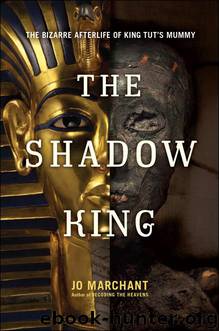The Shadow King by Jo Marchant

Author:Jo Marchant
Language: eng
Format: mobi, epub
ISBN: 9780306821349
Publisher: Da Capo Press
Published: 0101-01-01T00:00:00+00:00
LORD CARNARVON’S DEMISE wasn’t the only source of dramatic stories constructed from evidence that some might consider rather thin. Attention also focused on Tutankhamun’s own death, or to be more specific, his murder. The idea that the king was violently killed started with Ronald Harrison and the “eggshell thinning” he saw at the base of the mummy’s skull. But in 1996, thanks to a parapsychologist turned Egyptologist named Bob Brier, Tutankhamun’s murder hit the big time.
After making his human mummy in 1994, Brier, of Long Island University, was asked to make what he thought would be a low-profile documentary about Tutankhamun for the Learning Channel. But the resulting film caused a storm of interest, so Brier followed it with a book in 1998, called The Murder of Tutankhamen: A True Story, which itself became a best seller.15
What was so explosive? As part of his research, Brier had persuaded Robert Connolly, in Liverpool, to send him a copy of Harrison’s X-ray image of Tutankhamun’s skull. Brier showed the X-ray image to Gerald Irwin, a trauma specialist at nearby Winthrop University Hospital. Irwin scrutinized the area of eggshell thinness noted by Harrison, and agreed it could be caused by a brain hemorrhage. He also saw a faint line just above the affected area, which he interpreted as a hardened membrane that had formed over the hemorrhage. Such membranes are slow to form, suggesting that if the bleed was caused by a blow to the head, Tutankhamun had lingered on for weeks.
If so, reasoned Brier, the injured king must have been conscious for most of that time and able to eat and drink; otherwise, he would have died of dehydration or starvation before the membrane had time to form. The site of the supposed bleed was a very unusual one for such an injury—a well-protected spot at the back of the head, right where the neck joins the skull. The king must have been struck from behind, perhaps while sleeping on his front or side. Brier then added a large dose of dramatic imagination to these hints in order to construct what is still probably the most widely known version of Tutankhamun’s death. After the king went to bed alone, the door to his room silently opened and a man crept through:
Stealthily the night intruder made his way to Pharaoh’s bed, the sound of his steps perhaps obscured by the drip, drip of a water clock. He found the king sleeping on his side, his head supported by an alabaster headrest. From under his clothes the man drew out a heavy object, possibly an Egyptian mace that joined a solid three-inch stone to the end of a substantial two-foot stick. After a single deep breath, he swung the heavy object at Tutankhamun’s skull.16
The next morning, continues Brier, servants discovered the unconscious but not yet dead pharaoh and summoned a physician who regretfully announced that there was nothing he could do. Tutankhamun regained consciousness but then gradually weakened over the following weeks, and despite
Download
This site does not store any files on its server. We only index and link to content provided by other sites. Please contact the content providers to delete copyright contents if any and email us, we'll remove relevant links or contents immediately.
| Military | Political |
| Presidents & Heads of State | Religious |
| Rich & Famous | Royalty |
| Social Activists |
Waking Up in Heaven: A True Story of Brokenness, Heaven, and Life Again by McVea Crystal & Tresniowski Alex(37676)
Empire of the Sikhs by Patwant Singh(22977)
We're Going to Need More Wine by Gabrielle Union(18972)
Hans Sturm: A Soldier's Odyssey on the Eastern Front by Gordon Williamson(18486)
Leonardo da Vinci by Walter Isaacson(13189)
The Radium Girls by Kate Moore(11927)
Tools of Titans by Timothy Ferriss(8222)
Educated by Tara Westover(7945)
How to Be a Bawse: A Guide to Conquering Life by Lilly Singh(7394)
Permanent Record by Edward Snowden(5743)
The Last Black Unicorn by Tiffany Haddish(5558)
The Rise and Fall of Senator Joe McCarthy by James Cross Giblin(5229)
Promise Me, Dad by Joe Biden(5088)
The Wind in My Hair by Masih Alinejad(5034)
A Higher Loyalty: Truth, Lies, and Leadership by James Comey(4847)
The Crown by Robert Lacey(4728)
The Iron Duke by The Iron Duke(4293)
Joan of Arc by Mary Gordon(4016)
Stalin by Stephen Kotkin(3879)
